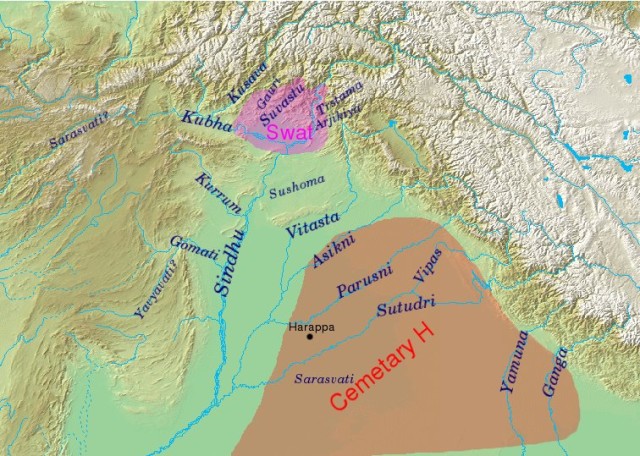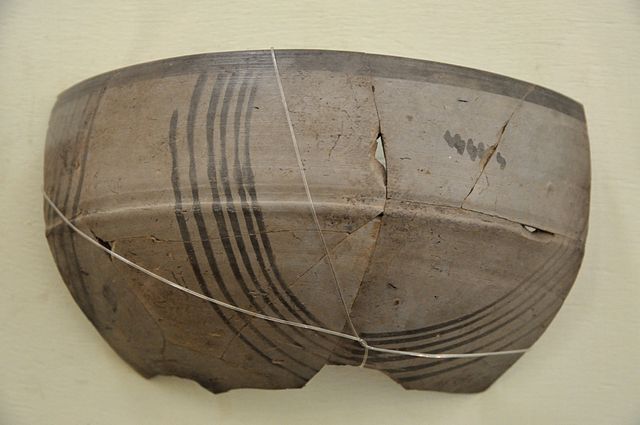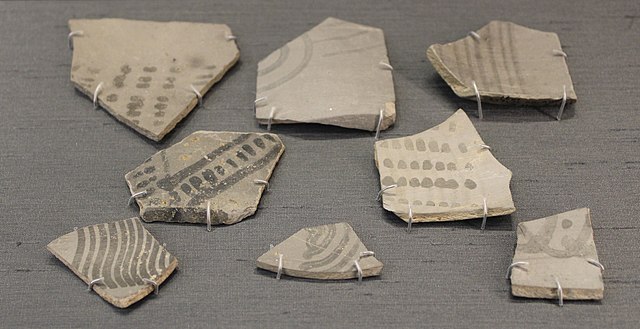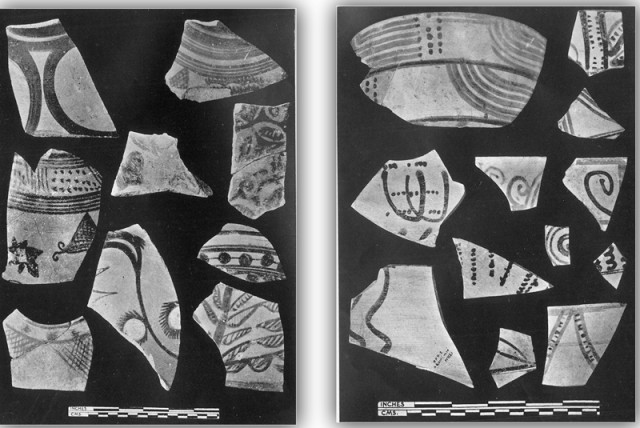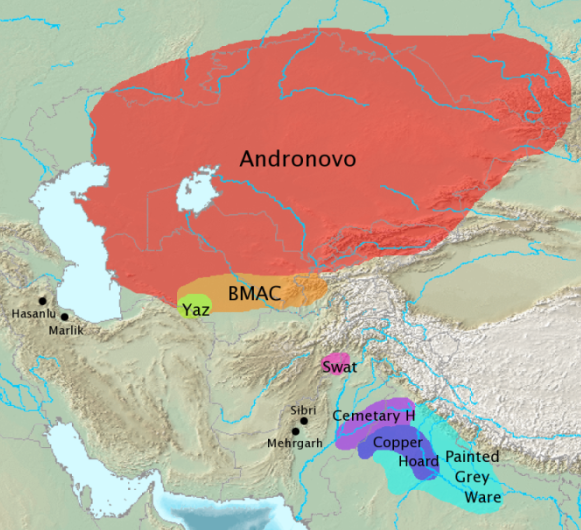
| PAINTED GREY WARE CULTURE
Map of some Painted Grey Ware (PGW) sites The Painted Grey Ware culture (PGW) is an Iron Age Indian culture of the western Gangetic plain and the Ghaggar-Hakra valley on the Indian subcontinent, conventionally dated c. 1200 to 600–500 BCE, though newer publications have suggested a range of 1500 to 700 BCE, or from 1300 to 500–300 BCE. It is a successor of the Cemetery H culture and Black and red ware culture (BRW) within this region, and contemporary with the continuation of the BRW culture in the eastern Gangetic plain and Central India.
Characterized by a style of fine, grey pottery painted with geometric patterns in black, the PGW culture is associated with village and town settlements, domesticated horses, ivory-working, and the advent of iron metallurgy. As of 2014, more than 1,100 PGW sites have been discovered. Although most PGW sites were small farming villages, "several dozen" PGW sites emerged as relatively large settlements that can be characterized as towns; the largest of these were fortified by ditches or moats and embankments made of piled earth with wooden palisades, albeit smaller and simpler than the elaborate fortifications which emerged in large cities after 600 BCE.
The PGW Culture probably corresponds to the middle and late Vedic period, i.e., the Kuru-Panchal kingdom, the first large state in the Indian subcontinent after the decline of the Indus Valley Civilization. The later vedic literature provides a mass of information on the life and culture of the times. It is succeeded by Northern Black Polished Ware from c.700-500 BCE, associated with the rise of the great mahajanapad states and of the Magadh Empire.
Overview :
Painted Grey Ware - Sonkh (Uttar Pradesh) - 1000 - 600 BCE. Government Museum, Mathura
Fragments of Painted Grey Ware, about 1000 BC, from Hastinapur and Radhakund, Uttar Pradesh, and Panipat and Tilpat, Haryana. British Museum
Shards of Painted Grey Ware (right) and Harappan red pottery (left) from Rupnagar, Punjab
Archaeological cultures associated with Indo-Iranian migrations (after EIEC) The
Andronovo, BMAC and Yaz cultures have often been associated with
Indo-Iranian migrations. The GGC (Swat), Cemetery H, Copper Hoard
and PGW cultures are candidates for cultures associated with Indo-Aryan
migrations.
The plough was used for cultivation. There are also indications of growing complexity of society as population increased and the size and number of settlements multiplied. Arts and crafts of the PGW people are represented by ornaments (made from terracotta, stone, faience, and glass), human and animal figurines (made from terracotta) as well as "incised terracotta discs with decorated edges and geometric motifs" which probably had "ritual meaning," perhaps representing symbols of deities. There are a few stamp seals with geometric designs but no inscription, contrasting with both the prior Harappan seals and the subsequent Brahmi-inscribed seals of the Northern Black Polished Ware culture.
The PGW pottery shows a remarkable degree of standardization. It is dominated by bowls of two shapes, a shallow tray and a deeper bowl, often with a sharp angle between the walls and base. The range of decoration is limited - vertical, oblique or criss-cross lines, rows of dots, spiral chains and concentric circles being common.
At Bhagwanpur in the Kurukshetra district of Haryana, excavations have revealed an overlap between the late Harappan and Painted Grey Ware cultures, large houses that may have been elite residences, and fired bricks that may have been used in Vedic altars.
Fresh surveys by archaeologist Vinay Kumar Gupta suggest Mathura was the largest PGW site around 375 hectares in area. Among the largest sites is also the recently excavated Ahichatra, with at least 40 hectares of area in PGW times along with evidence of early construction of the fortification which goes back to PGW levels. Towards the end of the period, many of the PGW settlements grew into the large towns and cities of the Northern Black Polished Ware period.
Chronology
:
On the other hand, Akinori Uesugi regards PGW as having three periods within North Indian Iron Age which are: Period I (1300-1000 BCE) when it makes its appearance in the Ghaggar valley and the upper Ganga region, Period II (1000-600 BCE) when it spreads into the western part of the Ganga valley, and Period III (600-300 BCE) with interactions to the east.
Vinay Kumar Gupta and B.R. Mani, in a recent analysis conclude that the earliest and late phases of PGW could have begun around 2300 BCE and 700 BCE respectively, making this the longest surviving pottery tradition in Indian archaeology, and they consider the Braj region as the core area of PGW, located in the Western banks of Yamuna river in the Mathura district, expanded to Hathras district in Uttar Pradesh, and to Bharatpur district in Rajasthan.
Interpretations
:
The pottery style of this culture is different from the pottery of the Iranian Plateau and Afghanistan (Bryant 2001). In some sites, PGW pottery and Late Harappan pottery are contemporaneous. The archaeologist Jim Shaffer (1984:84-85) has noted that "at present, the archaeological record indicates no cultural discontinuities separating Painted Grey Ware from the indigenous protohistoric culture." However, the continuity of pottery styles may be explained by the fact that pottery was generally made by indigenous craftsmen even after the Indo-Aryan migration. According to Chakrabarti (1968) and other scholars, the origins of the subsistence patterns (e.g. rice use) and most other characteristics of the Painted Grey Ware culture are in eastern India or even Southeast Asia. [note 1]
Recent
Research :
Excavation at Anuradhapur has unearthed PGW pottery from the 'Basal early historic' period of Anuradhapura (600 BC-500 BC) showing connections with North India.
Source :
https://en.wikipedia.org/ |
